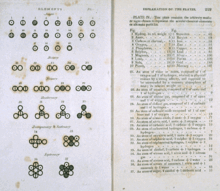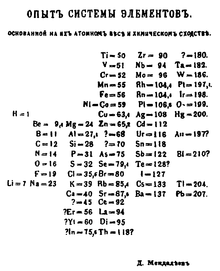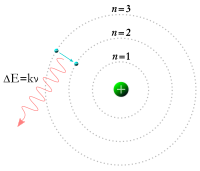ਪਰਮਾਣੂ: ਰੀਵਿਜ਼ਨਾਂ ਵਿਚ ਫ਼ਰਕ
ਛੋ robot Adding: vec:Àtomo |
|||
| ਲਾਈਨ 435: | ਲਾਈਨ 435: | ||
[[nov:Atome]] |
[[nov:Atome]] |
||
[[nrm:Atôme]] |
[[nrm:Atôme]] |
||
[[oc:Atòm]] |
|||
[[os:Атом]] |
[[os:Атом]] |
||
[[pam:Atom]] |
[[pam:Atom]] |
||
| ਲਾਈਨ 460: | ਲਾਈਨ 461: | ||
[[szl:Atům]] |
[[szl:Atům]] |
||
[[ta:அணு]] |
[[ta:அணு]] |
||
[[te:అణువు]] |
|||
[[tg:Атом]] |
[[tg:Атом]] |
||
[[th:อะตอม]] |
[[th:อะตอม]] |
||
23:57, 18 ਨਵੰਬਰ 2010 ਦਾ ਦੁਹਰਾਅ
ਪਰਮਾਣੂ(ਐਟਮ) ਮਾਅਦੇ(matter) ਦੀ ਮੂਲ ਇਕਾਈ ਹੈ ਜਿਸ ਵਿੱਚ ਇੱਕ ਸੰਘਣਾ, ਕੇਂਦਰੀ ਨਿਊਕਲੀਅਸ(ਕੇਂਦਰ) ਹੁੰਦਾ ਹੈ ਜਿਸ ਦੇ ਦੁਆਲੇ ਇਲੈਕਟ੍ਰੌਨਾਂ ਦਾ ਨੈਗੇਟਿਵ(ਰਿਣ) ਚਾਰਜ ਵਾਲਾ ਬੱਦਲ ਹੁੰਦਾ ਹੈ। ਨਿਊਕਲੀਅਸ(hydrogen-1 ਦੇ ਨਿਊਕਲੀਅਸ ਨੂੰ ਛੱਡ ਕੇ) ਵਿੱਚ ਪੌਜ਼ਿਟਿਵ(ਧਨ) ਚਾਰਜ ਵਾਲੇ ਪ੍ਰੋਟੌਨ ਅਤੇ ਨਿਰਪੱਖ ਚਾਰਜ ਵਾਲੇ ਨਿਊਟ੍ਰੌਨ ਦਾ ਮਿਸ਼ਰਣ ਹੁੰਦਾ ਹੈ। ਇਲੈਕਟ੍ਰੌਨ ਐਟਮ ਨਾਲ ਇਲੈਕਟ੍ਰੋਮੈਗਨੇਟਿਕ ਬਲ ਰਾਹੀਂ ਬੰਨ੍ਹੇ ਹੁੰਦੇ ਹਨ। ਐਟਮ ਇਕੱਠੇ ਹੋ ਕੇ ਅਣੂ ਬਣਾ ਸਕਦੇ ਹਨ। [1]
ਐਟਮ ਦੋ ਲਫ਼ਜ਼ਾਂ ਤੋਂ ਬਣਿਆ ਹੈ, "ἄτομος"—ਐਟਮੌਸ (α-, "ਅਨ-" + τέμνω - ਟੈਮਨੋ, "ਕੱਟਣਾ"[2]), ਜਿਸ ਦਾ ਮਤਲਬ ਹੈ ਨਾ ਕੱਟਿਆ ਜਾਂ ਵੰਡਿਆ ਜਾਣ ਵਾਲਾ।[3] ਮਾਅਦੇ ਦੀ ਨਾ ਵੰਡੀ ਜਾਣ ਵਾਲੀ ਇਕਾਈ ਵੱਜੋਂ ਸਭ ਤੋਂ ਪਹਿਲਾਂ ਐਟਮ ਨੂੰ ਭਾਰਤੀ ਅਤੇ ਗ੍ਰੀਕ ਫ਼ਿਲਾਸਫ਼ਰਾਂ ਨੇ ਮੰਨਿਆ। ੧੭ਵੀਂ ਅਤੇ ੧੮ਵੀਂ ਸਦੀ ਦੌਰਾਨ ਸਾਈਂਸਦਾਨਾਂ ਨੇ ਵਿਖਾਇਆ ਕਿ ਮਾਅਦੇ ਨੂੰ ਰਸਾਇਣਕ ਤਰੀਕਿਆਂ ਰਾਹੀਂ ਤੋੜਿਆ ਜਾ ਸਕਦਾ ਹੈ।੧੯ਵੀਂ ਅਤੇ ੨੦ਵੀਂ ਸਦੀ ਦੌਰਾਨ ਸਾਈਂਸਦਾਨਾਂ ਨੇ ਐਟਮ ਬਣਾਉਣ ਵਾਲੀਆਂ ਇਕਾਇਆਂ ਦੀ ਖੋਜ ਕਰ ਕੇ ਸਿੱਧ ਕੀਤਾ ਕਿ ਐਟਮ ਮੂਲ ਰੂਪ ਵਿੱਚ ਨਾ-ਟੁੱਟਣਯੋਗ ਨਹੀਂ ਹੈ। ਇਸ ਤੋਂ ਬਾਅਦ ਕੁਆਂਟਮ ਸਿਧਾਂਤ ਦਾ ਜਨਮ ਹੋਇਆ। [4][5]
ਵਿਗਿਆਨਕ ਸਿਧਾਂਤ ਦੀ ਉਤਪੱਤ

੧੭੮੯ ਵਿੱਚ, ਫ਼ਰਾਂਸੀਸੀ ਸਾਈਂਸਦਾਨ ਐਨਟੋਨੀ ਲੈਵੋਇਜ਼ੀਅਰ ਨੇ ਰਸਾਇਣਕ-ਭਾਰ ਦੇ ਸੰਭਾਲ ਦਾ ਨੇਮ ਪ੍ਰਕਾਸ਼ਿਤ ਕੀਤਾ।[6]
੧੮੦੩ ਵਿੱਚ, ਅੰਗਰੇਜ਼ੀ ਫ਼ਿਲਾਸਫ਼ਰ ਅਤੇ ਸਾਈਂਸਦਾਨ ਜੌਹਨ ਡਾਲਟਨ ਨੇ ਪਰਮਾਣੂ ਦਾ ਸਿਧਾਂਤ ਵਰਤ ਕੇ ਦਰਸਾਇਆ ਕਿ ਰਸਾਇਣਕ ਪ੍ਰਤਿਕਿਰਿਆਵਾਂ(chemical reaction) ਕਿਵੇਂ ਵਰਤਦੀਆਂ ਹਨ। [7][8][9]
ਇਸ ਸਿਧਾਂਤ ਨੂੰ ਵਧੇਰੇ ਨਰੋਆਪਣ ੧੮੨੭ ਵਿੱਚ ਰੌਬਰਟ ਬ੍ਰਾਊਨ ਦੇ 'ਬ੍ਰਾਓਨੀਅਨ ਮੋਸ਼ਨ' ਦੀ ਵਿਆਖਿਆ ਨੇ ਦਿੱਤਾ। ਜੇ.ਡੇਸੌਲਕਸ ਨੇ ੧੮੭੭ ਵਿੱਚ ਇਹ ਵਿਚਾਰ ਦਿੱਤਾ ਕਿ ਇਹ ਵਰਤਾਰਾ ਤਾਪ-ਬਲ ਕਰਕੇ ਹੁੰਦਾ ਹੈ ਅਤੇ ੧੯੦੫ ਵਿੱਚ ਐਲਬਰਟ ਆਈਂਸਟਾਈਨ ਨੇ ਇਸ ਨੂੰ ਹਿਸਾਬ ਦੀ ਵਰਤੋਂ ਕਰਕੇ ਸਿੱਧ ਕੀਤਾ। [10][11][12]ਫ਼੍ਰਾਂਸੀਸੀ ਭੌਤਿਕ ਵਿਗਿਆਨੀ, ਜੀਨ ਪੈਰਿਨ ਨੇ ਡਾਲਟਨ ਵੱਲੋਂ ਦਿੱਤੇ ਸਿਧਾਂਤ ਨੂੰ ਪ੍ਰਯੋਗਾਤਮਕ ਤਰੀਕੇ ਨਾਲ ਸਿੱਧ ਕੀਤਾ।[13]

ਪਹਿਲੀਆਂ ਖੋਜਾਂ ਦੇ ਆਧਾਰ ਉੱਤੇ ੧੮੬੯ ਵਿੱਚ ਦਮਿਤਰੀ ਮੈਂਡਲਈਵ ਨੇ ਪਹਿਲਾ ਪੀਰੀਆਡਿਕ ਟੇਬਲ ਬਣਾਇਆ।[14][15]
ਕੁਆਂਟਮ ਸਿੱਧਾਂਤ
ਜੇ.ਜੇ.ਥੌਮਸਨ ਨੇ ਕੈਥੋਡ ਕਿਰਨਾਂ ਉੱਪਰ ਕੀਤੀ ਸੋਧ ਦੇ ਆਧਾਰ ਉੱਤੇ ੧੮੯੭ ਵਿੱਚ ਇਲੈਕਟ੍ਰੌਨ ਦੀ ਖੋਜ ਕੀਤੀ। [16] ੧੯੦੯ ਵਿੱਚ ਗੀਗਰ ਅਤੇ ਮਾਰਸ਼ਡੈਨ ਨੇ ਅਰਨਸਟ ਰੁਦਰਫ਼ੋਰਡ ਦੀ ਅਗਵਾਈ ਹੇਠ ਪਰਮਾਣੂ ਦਾ ਰੁਦਰਫ਼ੋਰਡ ਮਾਡਲ ਦਿੱਤਾ।[17]

੧੯੧੩ ਵਿੱਚ ਨੀਲ ਬੋਹਰ ਨੇ ਦੱਸਿਆ ਕਿ ਇਲੈਕਟ੍ਰੌਨ ਨੂੰ ਨਿਊਕਲੀਅਸ ਦੁਆਲੇ ਨਿਸ਼ਚਤ ਬਲ ਵਾਲੀਆਂ ਔਰਬਿਟ ਮੁਹੱਈਆ ਕੀਤੀਆਂ ਗਈਆਂ ਹਨ। [18] ੧੯੩੨ ਵਿੱਚ ਚਾਡਵਿਕ ਨੇ ਇਊਕਲੀਅਸ ਵਿਚਲੇ ਨਿਊਟ੍ਰੌਨ ਦੀ ਖੋਜ ਕੀਤੀ। [19]
ਜ਼ਰੂਰੀ ਟਿੱਪਣੀਆਂ
ਹਵਾਲੇ
- ↑ Leigh, G. J., ed. (1990). International Union of Pure and Applied Chemistry, Commission on the Nomenclature of Inorganic Chemistry, Nomenclature of Organic Chemistry - Recommendations 1990. Oxford: Blackwell Scientific Publications. p. 35. ISBN 0-08-022369-9.
An atom is the smallest unit quantity of an element that is capable of existence whether alone or in chemical combination with other atoms of the same or other elements.
- ↑ Liddell, Henry George; Scott, Robert. "A Greek-English Lexicon". Perseus Digital Library.
{{cite web}}: CS1 maint: multiple names: authors list (link) - ↑ Liddell, Henry George; Scott, Robert. "ἄτομος". A Greek-English Lexicon. Perseus Digital Library. Retrieved 2010-06-21.
{{cite web}}: CS1 maint: multiple names: authors list (link) - ↑ Haubold, Hans; Mathai, A.M. (1998). "Microcosmos: From Leucippus to Yukawa". Structure of the Universe. Retrieved 2008-01-17.
- ↑ Harrison (2003:123–139).
- ↑ "Lavoisier's Elements of Chemistry". Elements and Atoms. Le Moyne College, Department of Chemistry. Retrieved 2007-12-18.
- ↑ Wurtz (1881:12).
- ↑ Dalton (1808).
- ↑ Patterson, Elizabeth C. (1970). John Dalton and the Atomic Theory. Garden City, New York: Anchor.
- ↑
Einstein, Albert (1905). "Über die von der molekularkinetischen Theorie der Wärme geforderte Bewegung von in ruhenden Flüssigkeiten suspendierten Teilchen" (PDF). Annalen der Physik (in German). 322 (8): 549–560. doi:10.1002/andp.19053220806. Retrieved 2007-02-04.
{{cite journal}}: CS1 maint: unrecognized language (link) - ↑ Mazo (2002:1–7).
- ↑
Lee, Y.K. (1995). "Brownian Motion". Imperial College. Retrieved 2007-12-18.
{{cite web}}: Unknown parameter|coauthors=ignored (|author=suggested) (help) - ↑ Patterson, G. (2007). "Jean Perrin and the triumph of the atomic doctrine". Endeavour. 31 (2): 50–53. doi:10.1016/j.endeavour.2007.05.003.
- ↑ "Periodic Table of the Elements". The International Union of Pure and Applied Chemistry. November 1, 2007. Retrieved 2010-05-14.
- ↑ Scerri (2007:10–17).
- ↑ "J.J. Thomson". Nobel Foundation. 1906. Retrieved 2007-12-20.
- ↑ Rutherford, E. (1911). "The Scattering of α and β Particles by Matter and the Structure of the Atom" (PDF). Philosophical Magazine. 21: 669–88.
- ↑ Stern, David P. (16 May 2005). "The Atomic Nucleus and Bohr's Early Model of the Atom". NASA/Goddard Space Flight Center. Retrieved 2007-12-20.
- ↑ Chadwick, James (12 December 1935). "Nobel Lecture: The Neutron and Its Properties". Nobel Foundation. Retrieved 2007-12-21.
<ref> tag with name "slac_20090615" defined in <references> is not used in prior text.ਕਿਤਾਬੀ ਹਵਾਲੇ
- L'Annunziata, Michael F. (2003). Handbook of Radioactivity Analysis. Academic Press. ISBN 0124366031. OCLC 162129551.
- Beyer, H. F. (2003). Introduction to the Physics of Highly Charged Ions. CRC Press. ISBN 0750304812. OCLC 47150433.
{{cite book}}: Unknown parameter|coauthors=ignored (|author=suggested) (help) - Choppin, Gregory R. (2001). Radiochemistry and Nuclear Chemistry. Elsevier. ISBN 0750674636. OCLC 162592180.
{{cite book}}: Unknown parameter|coauthors=ignored (|author=suggested) (help) - Dalton, J. (1808). A New System of Chemical Philosophy, Part 1. London and Manchester: S. Russell.
- Demtröder, Wolfgang (2002). Atoms, Molecules and Photons: An Introduction to Atomic- Molecular- and Quantum Physics (1st ed.). Springer. ISBN 3540206310. OCLC 181435713.
- Feynman, Richard (1995). Six Easy Pieces. The Penguin Group. ISBN 978-0-140-27666-4. OCLC 40499574.
- Fowles, Grant R. (1989). Introduction to Modern Optics. Courier Dover Publications. ISBN 0486659577. OCLC 18834711.
- Gangopadhyaya, Mrinalkanti (1981). Indian Atomism: History and Sources. Atlantic Highlands, New Jersey: Humanities Press. ISBN 0-391-02177-X. OCLC 10916778.
- Goodstein, David L. (2002). States of Matter. Courier Dover Publications. ISBN 013843557X. ISBN 0-486-49506-X.
- Harrison, Edward Robert (2003). Masks of the Universe: Changing Ideas on the Nature of the Cosmos. Cambridge University Press. ISBN 0521773512. OCLC 50441595.
- Iannone, A. Pablo (2001). Dictionary of World Philosophy. Routledge. ISBN 0415179955. OCLC 44541769.
- Jevremovic, Tatjana (2005). Nuclear Principles in Engineering. Springer. ISBN 0387232842. OCLC 228384008.
- Lequeux, James (2005). The Interstellar Medium. Springer. ISBN 3540213260. OCLC 133157789.
- Levere, Trevor, H. (2001). Transforming Matter – A History of Chemistry for Alchemy to the Buckyball. The Johns Hopkins University Press. ISBN 0-8018-6610-3.
{{cite book}}: CS1 maint: multiple names: authors list (link) - Liang, Z.-P. (1999). Webster, J. G. (ed.). Encyclopedia of Electrical and Electronics Engineering: Magnetic Resonance Imaging (PDF). Vol. vol. 2. John Wiley & Sons. pp. 412–26. ISBN 0471139467. Retrieved 2008-01-09.
{{cite book}}:|volume=has extra text (help); Unknown parameter|coauthors=ignored (|author=suggested) (help) - MacGregor, Malcolm H. (1992). The Enigmatic Electron. Oxford University Press. ISBN 0195218337. OCLC 223372888.
- Manuel, Oliver (2001). Origin of Elements in the Solar System: Implications of Post-1957 Observations. Springer. ISBN 0306465620. OCLC 228374906.
- Mazo, Robert M. (2002). Brownian Motion: Fluctuations, Dynamics, and Applications. Oxford University Press. ISBN 0198515677. OCLC 48753074.
- Mills, Ian (1993). Quantities, Units and Symbols in Physical Chemistry (2nd ed.). Oxford: International Union of Pure and Applied Chemistry, Commission on Physiochemical Symbols Terminology and Units, Blackwell Scientific Publications. ISBN 0-632-03583-8. OCLC 27011505.
{{cite book}}: Unknown parameter|coauthors=ignored (|author=suggested) (help) - Moran, Bruce T. (2005). Distilling Knowledge: Alchemy, Chemistry, and the Scientific Revolution. Harvard University Press. ISBN 0674014952.
- Myers, Richard (2003). The Basics of Chemistry. Greenwood Press. ISBN 0313316643. OCLC 50164580.
- Padilla, Michael J. (2002). Prentice Hall Science Explorer: Chemical Building Blocks. Upper Saddle River, New Jersey USA: Prentice-Hall, Inc. ISBN 0-13-054091-9. OCLC 47925884.
{{cite book}}: Unknown parameter|coauthors=ignored (|author=suggested) (help) - Pauling, Linus (1960). The Nature of the Chemical Bond. Cornell University Press. ISBN 0801403332. OCLC 17518275.
- Pfeffer, Jeremy I. (2000). Modern Physics: An Introductory Text. Imperial College Press. ISBN 1860942504. OCLC 45900880.
{{cite book}}: Unknown parameter|coauthor=ignored (|author=suggested) (help) - Ponomarev, Leonid Ivanovich (1993). The Quantum Dice. CRC Press. ISBN 0750302518. OCLC 26853108.
- Scerri, Eric R. (2007). The periodic table: its story and its significance. Oxford University Press US. ISBN 0195305736.
- Shultis, J. Kenneth (2002). Fundamentals of Nuclear Science and Engineering. CRC Press. ISBN 0824708342. OCLC 123346507.
{{cite book}}: Unknown parameter|coauthors=ignored (|author=suggested) (help) - Siegfried, Robert (2002). From Elements to Atoms: A History of Chemical Composition. DIANE. ISBN 0871699249. OCLC 186607849.
- Sills, Alan D. (2003). Earth Science the Easy Way. Barron's Educational Series. ISBN 0764121464. OCLC 51543743.
- Smirnov, Boris M. (2003). Physics of Atoms and Ions. Springer. ISBN 038795550X. ISBN 0-387-95550-X.
- Teresi, Dick (2003). Lost Discoveries: The Ancient Roots of Modern Science. Simon & Schuster. pp. 213–214. ISBN 074324379X.
- Various (2002). Lide, David R. (ed.). Handbook of Chemistry & Physics (88th ed.). CRC. ISBN 0849304865. OCLC 179976746. Retrieved 2008-05-23.
{{cite book}}: More than one of|author=and|last=specified (help) - Woan, Graham (2000). The Cambridge Handbook of Physics. Cambridge University Press. ISBN 0521575079. OCLC 224032426.
- Wurtz, Charles Adolphe (1881). The Atomic Theory. New York: D. Appleton and company. ISBN 055943636X.
- Zaider, Marco (2001). Radiation Science for Physicians and Public Health Workers. Springer. ISBN 0306464039. OCLC 44110319.
{{cite book}}: Unknown parameter|coauthors=ignored (|author=suggested) (help) - Zumdahl, Steven S. (2002). Introductory Chemistry: A Foundation (5th ed.). Houghton Mifflin. ISBN 0-618-34342-3. OCLC 173081482. Retrieved 2008-02-05.
ਬਾਹਰਲੇ ਲਿੰਕ
- Francis, Eden (2002). "Atomic Size". Clackamas Community College. Retrieved 2007-01-09.
- Freudenrich, Craig C. "How Atoms Work". How Stuff Works. Retrieved 2007-01-09.
- "Atom:The Atom". Free High School Science Texts: Physics. Wikibooks. Retrieved 2007-01-09.
- Anonymous (2007). "The atom". Science aid+. Retrieved 2007-01-09.—a guide to the atom for teens.
- Anonymous (2006-01-03). "Atoms and Atomic Structure". BBC. Retrieved 2007-01-11.
- Various (2006-01-03). "Physics 2000, Table of Contents". University of Colorado. Retrieved 2008-01-11.
- Various (2006-02-03). "What does an atom look like?". University of Karlsruhe. Retrieved 2008-05-12.
